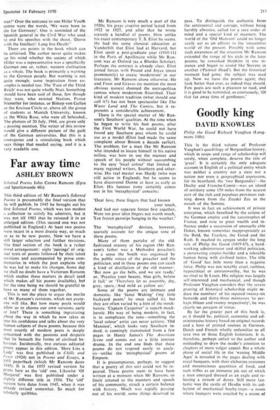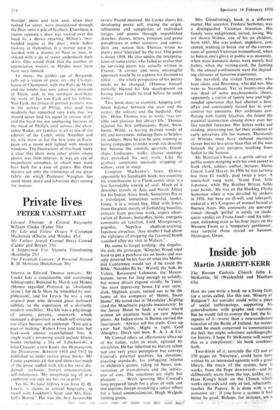Goodly king
DAVID KNOWLES
Philip the Good Richard Vaughan (Long- mans 110s) This is the third volume of Professor Vaughan's quadrilogy of Burgundian history, which in scope and range of scholarship will surely, when complete, deserve the title of 'great'. It is certainly the only adequate account in English of a political entity which was neither a country nor a state nor a nation nor even a geographical expression, for its heartland, the 'two Burgundies'—the Duchy and Franche-Comte—was an island of territory some 150 miles from the nearest part of the rich and populous provinces run- ning down from the Zuyder Zee to the mouth of the Somme.
It was in fact an achievement of private enterprise, which benefited by the eclipse of the German empire and the catastrophes of France, and rose to great wealth and in- fluence under a succession of unusually able Dukes, known somewhat inappropriately as the Bold, the Fearless, the Good and the Rash. It reached its apogee under the long rule of Philip the Good (1419-67), a hard- working administrator and skilful politician, a persevering empire-builder and a tolerable human being with civilised tastes. The title of 'Good' has little more than a negative force. Philip was not notably cruel, ruthless, hypocritical or untrustworthy, but he was no rival to St Louis. His religion was largely self-interested and mechanical, and though Professor Vaughan considers that `the severe pruning of historical scholarship might re- duce the numbers' of his reputed twenty-six bastards and thirty-three mistresses `to per- haps fifteen and twenty respectively', he was clearly no paragon of virtue.
By far the greater part of this book is, as it should be, political, economic and ad- ministrative history based on original records and a host of printed sources in German,
Dutch and French wholly unfamiliar to all save two or three English historians. It is, therefore, perhaps unfair to the author and misleading to draw the reader's attention to chapters of more vulgar appeal. But a whole phase of social life in the 'waning Middle Ages' is revealed in the pages dealing with royal banquets, with their elaborate costumes and mountainous quantities of food, and such trifles as an immense pie out of which a man emerged dressed as an eagle and re- leasing a stream of doves. Still more fan- tastic was the castle of Hesdin with its col- lection of mechanical booby-traps—a room where loungers were assailed by a storm of
thunder, snow and rain, and, when they rushed for cover, were precipitated through the floor onto a pile of feathers. Elsewhere, a visitor opening a door was socked over the head by a device recalling Milton's 'two- handed engine at the door', while ladies looking at themselves in a mirror were re- warded with a shower of flour or soot, or sluiced with a jet of water underneath their skirts. One would think that the number of appreciative visitors to Hesdin must have been very limited.
To many, the golden age of Burgundy calls up a vision of great art—the Charter- house of Champmol, with the Puits de Moise and the tombs that now adorn the museum of Dijon, and, in the northern provinces. the work of Jan van Eyck and his fellows. Van Eyck, the prince of portrait painters, was in the service of Philip, who paid him modestly but remarked very truly that 'we should never find his equal in artistic skill'; and the hard but not unpleasing features of the head of Philip's civil service, the chan- cellor Rodin, are familiar to all as one of the adorers of the Lamb, while Arnolfini and his wife show us for the first time in Euro- pean art a room well lighted with modern windows. The illustrations of this book make it clear that there were other artists whose genius was little inferior. It was an age of magnificent costumes, in which men wore hats built for a race of giants. But these matters are only the trimmings of the great fabric on which Professor Vaughan has spent many dusty and laborious days among the sources.



































 Previous page
Previous page